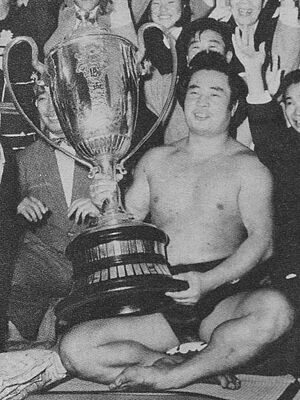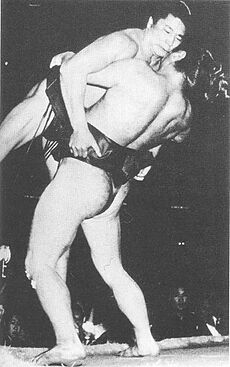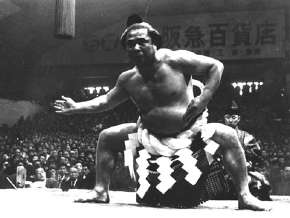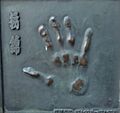Tochinishiki Kiyotaka facts for kids
Quick facts for kids Tochinishiki Kiyotaka |
|
|---|---|
| 栃錦 清隆 | |

Tochinishiki holding the Emperor's Cup after winning the September 1954 tournament
|
|
| Personal information | |
| Born | Ōtsuka Kiyoshi February 20, 1925 Tokyo, Japan |
| Died | January 10, 1990 (aged 64) |
| Height | 1.77 m (5 ft 9+1⁄2 in) |
| Weight | 132 kg (291 lb) |
| Career | |
| Stable | Kasugano |
| Record | 576–244–32–1 draw |
| Debut | January, 1939 |
| Highest rank | Yokozuna (October 1954) |
| Retired | May, 1960 |
| Elder name | Kasugano |
| Championships | 10 (Makuuchi) |
| Special Prizes | Outstanding Performance (1) Technique (9) |
| Gold Stars | 1 (Azumafuji) |
| * Up to date as of June 2020. | |
Tochinishiki Kiyotaka (Japanese: 栃錦 清隆, February 20, 1925 – January 10, 1990) was a famous Japanese professional sumo wrestler from Tokyo. He became the 44th yokozuna, which is the highest rank in sumo. Tochinishiki won ten major sumo tournaments. He was also a big rival of another great yokozuna named Wakanohana I. After he stopped wrestling, he became the main coach for Kasugano stable in 1959. Later, he even led the Japan Sumo Association, which is like the main organization for sumo, from 1974 to 1988.
Contents
Becoming a Sumo Star: Tochinishiki's Early Life
Tochinishiki was born as Ōtsuka Kiyoshi (大塚 清) in Tokyo. He later changed his name to Nakata Kiyoshi (中田 清). Unlike many sumo wrestlers who came from the countryside, he grew up in the city. When he was a child, he was a very good athlete in many sports. Even though his family wasn't involved in sumo, a shop owner introduced him to Kasugano Oyakata. This was a former yokozuna named Tochigiyama.
Tochinishiki started his professional sumo career in January 1939. He was quite small back then. He even had to drink a lot of water to meet the weight rules for his first physical exam! His coach, Tochigiyama, believed in him a lot. Tochinishiki worked closely with his coach as an assistant. He started using his famous sumo name, Tochinishiki, in May 1944.
Rising Through the Ranks: Tochinishiki's Top Division Career
Tochinishiki reached the top sumo division, called makuuchi, in June 1947. He wasn't the biggest wrestler, but he was incredibly skilled. He was known for his amazing technique. He won the special "Technique Prize" nine times! Some people even thought the prize was created just for him because he was so good. Tochinishiki was also called the Mamushi, which means "Viper." This nickname came from how tough and determined he was when he grabbed his opponent's mawashi (the belt they wear).
In January 1951, he had a tough start, losing seven matches in a row. But he didn't give up! He came back to win eight matches in a row. He secured a winning record, called kachi-koshi, on the very last day of the tournament. After this impressive comeback, Tochinishiki quickly moved up the sumo ranks. He won his first top division championship in September 1952. This led to him being promoted to ōzeki, the second-highest rank.
He finally reached the highest rank of yokozuna in October 1954. This happened after he won two championships in a row. Before his promotion, there were four yokozuna wrestlers. One of them, Azumafuji, decided to retire. This made it easier for Tochinishiki to get his promotion.

When Tochinishiki became a yokozuna, he expected his coach to praise him. Instead, his coach told him, "From this day on, you should spend every day of your yokozuna life thinking about the day you retire." This was a reminder to always work hard and stay humble. At first, he found it hard to fight against heavier wrestlers. So, he gained some weight, reaching about 130 kg (286 lbs). This helped him use more traditional sumo moves. Between March 1959 and March 1960, he had an amazing record, winning 95 matches and losing only 10.
Tochinishiki had a famous rivalry with another yokozuna, Wakanohana Kanji I. Wakanohana reached the top rank in January 1958. Both wrestlers were similar in size. Each of them won ten top division tournament championships during their careers. Tochinishiki had a slight edge in their head-to-head matches, winning 19 out of 35 bouts. In July 1959, he won a championship with a perfect 15–0 score. This was incredible, especially since his father had passed away just the day before.
In October 1959, his stablemaster, Tochigiyama, suddenly died. Tochinishiki then became the head coach of Kasugano stable. He was still an active wrestler at the time, which is not allowed in sumo today. After losing a championship match to Wakanohana in March 1960, he decided to retire from wrestling. This happened just two days into the next tournament.
Tochinishiki's Life After Wrestling
After retiring from wrestling, Tochinishiki continued to be very important in the sumo world. Besides being a stable boss, he also became the chairman of the Japan Sumo Association. He held this powerful position from 1974 to 1988. He was the longest-serving chairman in sumo history!
Under his leadership, a new main sumo arena, the Ryōgoku Kokugikan, was built in 1985. Tochinishiki had diabetes, so he chose to step down from his role. This allowed his old rival, Wakanohana, to become the next chairman. In 1985, during his time as chairman, Tochinishiki performed his kanreki dohyō-iri. This is a special ceremony for yokozuna who turn 60 years old. It celebrates their time at the highest rank.
Tochinishiki passed away in January 1990 after having a stroke. He was going to retire from the Sumo Association the next month, when he would have turned 65.
Images for kids
See also
- Glossary of sumo terms
- Kanreki dohyo-iri
- List of past sumo wrestlers
- List of sumo tournament top division champions
- List of sumo tournament top division runners-up
- List of yokozuna



